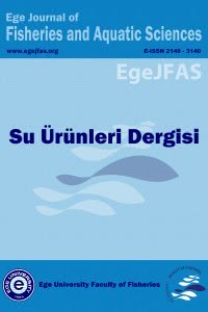Yeşil Deniz alglerinden Ulva rigida (C. Agardh)' nın besin kompozisyonu ve aminoasit içeriklerinin mevsimsel değişimi
uçucu amino asitler, besin maddesi içeriği, mevsimsel değişimler, besin değeri
The seasonal variation of proximate composition and amino acid contents of a green algae Ulva rigida (C. Agardh)
___
- Arasaki, A., and T. Arasaki. 1983. Vegetables from the Sea. Japan Pub. Inc., p: 39-42.
- AOAC, 2000. Official Methods of Analysis. 17th Edition Vol II. Assoc. Off. Anal. Chem., Wash. D.C., USA.
- Burtin, P. 2003. Nutritional Value Of Seaweeds. Electronic Journal of Environmental, Agricultural and Food Chemistry. 2 (4): 498-503.
- Garcia-Casal, M.N., A.C. Pereira, I. Leets, J. Ramirez, and M. F. Quiroga. 2008. High Iron Content and Bioavailability in Humans from Four Species of Marine Algae. The Journal of Nutrition, p: 2691-2695.
- Cirik, Ş., S. Cirik. 1999. Aquatic Plants (The biology, ecology and aquaculture tecniques of seaweeds), (in Turkish). Ege Üniversitesi Su Ürünleri Fakültesi Yayınları, No: 58, 188s.
- Cirik, Ş. 2001. The seaweeds of Gökova Bay, (in Turkish). D.E.U. Deniz Bilimleri ve Teknolojisi Enstitüsü, Piri Reis Yayınları No: 3, İzmir.
- Dawes, C. J. 1998. Marine Botany. JohnWiley&Sons, Inc., New York, p.480.
- Darcy-Vrillon, B. 1993. Nutritional aspects of the developing use of marine macroalgae for the human food industry. Int. J.Food Sci. Nutr., 44: 23-35.
- Drum, R. 2003. Sea Vegetables for Food and Medicine, http://www. partnerearteducationcenter.com/sexpan1.html
- FAO. 2005. World aquaculture production of aquatic plants by producers in 2005.
- Fleurence, J. 1999. Seaweed proteins: Biochemical, nutritional aspects and potential uses. Trends in Food Science and Technology, 10: 25–28.
- Folch, J., M. Lees, and G. H. S. Sloane-Stanley. 1957. A simple method for the isolation and purification of total lipids from animal tissues. J. Biol. Chem., 226: 497−509.
- Güner, H., and V. Aysel. 1999. The systematic of Cryptogams, (in Turkish). Ege Üniversitesi Fen Fakültesi Kitaplar Serisi No: 108, 249s.
- Lahaye, M. 1991. Marine algae as sources of fibers: Determination of soluble and insoluble dietary fiber contents in some, sea vegetables. Journal of Science and Food Agriculture, 54: 587–594.
- Mabeau, S., E. Cavaloc, J. Fleurence, and M. Lahaye. 1992. New seaweed based ingredients for the food industry. International Food Ingredients, 3: 38-45.
- Morales, M.A., M.C. Valdez, S.C. Dominguez, B.G. Acosta, and F.P. Gil. 2005. Chemical composition and microbiological assays of marine algae Enteromorpha spp. as a potential food source. Journal of Food Composition and Analysis. 18: 79-88.
- Munda, I., and F. Gubensek. 1986. The amino acid content of some benthic algae from Northern Adriatic. Bot. Mar., 29: 367-372.
- Ortiz, J., N. Romeo, P. Robert, J. Araya, J. Lopez-Hernandez, C. Bozzo, E. Navarrete, A. Osorio, and A. Rios. 2005. Dietary fiber, amino acid, fatty acid and tocopherol content of the edible seaweeds Ulva lactuca and Durvillaea antarctica. Food Chemistry, 99: 98-104.
- Pádua, M., P.S.G. Fontoura, and A.L. Mathias. 2004. Chemical Composition of Ulvaria oxysperma (Kützing) Bliding, Ulva lactuca (Linnaeus) and Ulva fascita (Delile). Brazilian archives of biology and technology, 47: 49-55.
- Pal, D., D. Parakash, and D.V. Amla. 1998. Chemical composition of the green algae Botrycocus barunii. Cryptogamie, Algol., 19 (4): 311-317.
- Parekh, RG., L.V. Maru, and M.J. Dave. 1977. Chemical Composition of Green Seaweeds of Saurashtra Coast. Botanica Marina, 20: 359-362.
- Rupe´rez, P., O. Ahrazem, and J. A. Leal. 2002. Potencial antioxidant capacity of sulfated polysaccharides from the edibic marine brown seeweed Fucus vesiculosus. Journal of Agricultural and Food Chemistry, 50: 840–845.
- Southgate, D. A. T. 1990. Dietary fiber and health. In D. A. T. Southgate, K. Waldron, I. T. Johnson, & G. R. Fen-wick, Dietary fiber: Chemical and biological aspects (pp. 10-19). Cambridge: The Royal Society of Chemistry.
- Steel, R.G.D., and J. H. Torrie. 1960. Principles and Procedures of Statistics: A Biometric Approach, 2nd edn. McGraw–Hill, New York, 633 pp.
- Valente, L.M.P., A. Gouveia, P. Rema, J. Matos, E.F. Gomes, and I. S. Pinto. 2006. Evaluation of three seaweeds Gracilaria bursa-pastoris, Ulva rigida and Gracilaria cornea as dietary ingredients in European sea bass (Dicentrarchus labrax) juveniles. Aquaculture, 252: 85–91.
- Wong, K.H., and P.C.K. Cheung. 2000. Nutritional evaluation of some subtropical red and green seaweeds Part I. Proximate composition, amino acid profiles and some physico-chemical properties. Food Chemistry, 71: 475-482
- ISSN: 1300-1590
- Yayın Aralığı: 4
- Başlangıç: 1984
- Yayıncı: Aynur Lök
Özcan YEGANE, Hatice PARLAK, Özlem Çakal ARSLAN, Meltem BOYACOĞLU
Küresel ısınma ve iklim değişikliği
NACİYE ERDOĞAN SAĞLAM, ERTUĞ DÜZGÜNEŞ, İSMET BALIK
The biometric analysis of pipefish species from çamaltı lagoon (İzmir Bay, Aegean Sea)
Edremit Körfezi demersal balıkçılık kaynakları üzerine bir araştırma
AYDIN ÜNLÜOĞLU, SENCER AKALIN, Dilek Türker ÇAKIR
Batı Karadeniz bölgesi içsularının balık faunası
Fatih BAŞARAN, Berkan AYDOĞAN, ŞÜKRÜ ŞENOL PARUĞ, GÜLNUR METİN, ALİ ULAŞ, HÜLYA SAYĞI, Bora SEZEN, Belgin HOŞSUCU
The Salmonella mutagenicity of sediments from Gediz River (Western Turkey)
MELTEM BOYACIOĞLU, Hatice PARLAK, Özlem Çakal ARSLAN
